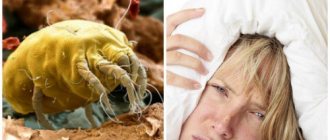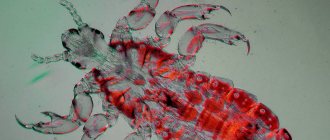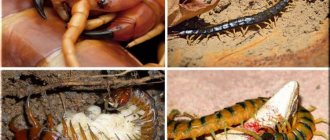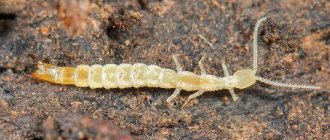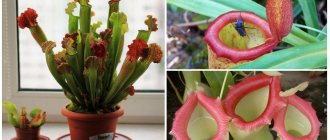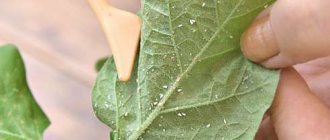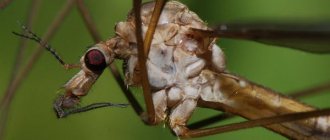Description of springtail
Springtails, or springtails, are extremely widespread, especially in temperate latitudes, there are many of them in the tropics, they are found both in the Arctic and Antarctic - wherever there are at least mosses and lichens.
This is interesting! Springtails , or springtails (Collembola) - a subclass of arthropods, in the modern classification classified as cryptognathous. Currently, scientists have described more than 8 thousand species of springtails.
Springtail Tomocerus vulgaris.
These insects most often live among rotting plant remains and in the surface layer of soil, but many also live deep in the soil, often penetrating deeper than other animals. Among springtails, there are also those that live on the surface of plants, and there are even those that have passed on to life on the surface of a film of water.
The number of springtails is also very large. For example, in the soils of forests and meadows there are often several tens of thousands of springtails per square meter. Springtails are very diverse both in body shape and color: as a rule, species that live in the soil and do not leave it are white, springtails that live on the surface of green plants, greenish, but among those living in the forest litter or in the felt of dead herbaceous plants , along with grayish and brown ones, brightly colored or metallic shiny species are not uncommon.
Springtail Orchesella villosa.
Those springtails that live on the soil surface can move in a very unique way. As already noted, on the lower surface of the posterior end of the abdomen there is a special organ not found in other arthropods, the so-called “jumping fork.” In a calm state, it is tucked under the abdomen. Quickly straightening this “fork”, the collembola pushes off from the object on which it sits and makes a sharp jump.
Springtails that stay on the surface of the water (there are some) can jump, pushing off even from the surface film of water - their body is not wetted by water.
White springtails, which always live in the ground and do not appear on the surface, do not have a "jumping fork"; they can only crawl with the help of short chest legs, often not even noticeable when viewed from above. A number of springtails harm plants, such as green smintur onychiura , which eat en masse into the succulent roots of greenhouse plants .
Some species probably cause harm indirectly by spreading fungal spores that cause plant diseases.
Control measures
So, the bugs have appeared, here’s one, there’s a second one crawling along the birch tree - it’s time to sound the alarm! But you shouldn’t rush headlong to the store and buy drugs containing chemicals, maybe we’ll make do with folk remedies for now?
The simplest of them are onion decoctions (250 g per bucket of water, the norm per square meter of soil of infected plants), wood ash (200 g per bucket of water, this is also a passable potash fertilizer and also the norm per square meter of infected plants), mustard powder (100 g per bucket of water, the norm per square meter of infected plants), laundry soap (you can use a whole piece, the norm per square meter of infected plants).
Planting black cohosh (especially for Botanichka readers - this is a plant belonging to the Buttercup family) or black cohosh (here the name speaks for itself) can also help. For some unknown reason, the smell of these plants makes the soldiers feel bad, and they try to set up a base in a neighboring area, leaving yours alone.
Next comes artillery, a little more powerful, but still biological. This is the Baikal drug, it must be diluted in strict accordance with the instructions on the package, but usually six milliliters are diluted in a bucket of water, a spray bottle is filled and the beetles or infected areas of crops are spot-treated.
Chemicals. Here you need to be careful - serious chemistry requires compliance with mandatory processing times, doses, drugs must be approved for use, and so on and so forth. More recently, Karbofos and Aktara effectively fought against the beetle; they caused paralysis in insects and they simply died.
A cluster of soldier bugs on a tree trunk. Daniel VILLAFRUELA
Is it necessary to fight springtails?
In general, springtails are not only harmless, but even useful: they contribute to the decomposition, transformation into humus and mineralization of plant residues and, according to modern data, play a very important role in soil formation. So don’t rush to remove your springtail with the fury of a tiger, as the chemical may be more harmful to your pet than the springtail itself .
Collembola genus Paratullbergia callipygos subfamily Onychiuridae
Green minthurus, alfalfa flea beetle (Sminthurus viridis)
How to recognize collembola?
The size of springtails ranges from 0.2 mm to 10 mm (very few species). Springtails prefer a secretive lifestyle in places with high humidity. They live in the soil, under the bark of dead trees, in leaf litter, and in cracks in stones. Springtails feed on fungal mycelium, bacterial plaque, algae, mosses, and lichens. Only a few species can feed on higher plants. Unfortunately, this is exactly what flower growers are faced with.
Identifying these representatives of the animal world is quite difficult. There are many views on the taxonomy of springtails, as a result of which many synonymous names are mentioned in the literature.
The small size and secretive lifestyle of springtails make it difficult to study them. The lack of accessible and complete identification literature on these groups of insects makes it almost impossible for non-professionals to identify springtails.
Fortunately, the biology of soil springtails is similar enough that precise identification is not required. It is enough to know that these are springtails and not to confuse them with other insects (thrips, rootworms) and mites. To develop adequate control measures, if necessary.
Water springtail, or water forktail (Podura aquatica).
Benefits and harms
It's time to present the arguments for and against springtails. There is something in us humans that makes us attack and kill even the most harmless creatures just because we don’t like their appearance, or accidentally crossed our path. All of the above also applies to springtails - these are completely harmless creatures.
However, there is a problem, and it needs to be solved, so first we will describe the negative side of this insect.
Harm
What forces us to fight collembola is not the threat of being bitten or the threat to our food supplies. No, this is ordinary disgust, which can lead some people to panic.
Of course, it’s unpleasant if you find a herd of springtails in your apartment. Instead of just collecting them and throwing them out into the street, we will begin to fight them.
Naturally, the most favorite places in our home for springtails are damp rooms: the corners of the kitchen under the sink, the corners under the plumbing fixtures in the bathroom. Particular accumulations are observed in areas of leakage. There, under constant drops of water, mold forms - the favorite food of fools.
The appearance of springtails in a sparkling clean bathroom is perceived by people as something terrible, and the hand itself reaches for a bottle of Dichlorvos or another similar product.
The second case of sabotage can be observed on indoor plants. Here, springtails can crawl along the soil in a pot, and especially impudent individuals can even try to gnaw on the leaves. Of course, here too it is necessary to take measures for destruction.
Benefit
Before we start fighting collembola, even in a separate article, we’ll tell you about the benefits these amazing creatures bring. Here we can observe two sides of the insect's usefulness.
Firstly, by eating tons of dead organic matter, springtails transform it into exactly that substance that all gardeners adore - humus. The feces of these insects are almost ready-made food for microorganisms, and the products of subsequent decay are already absorbed by our plants. Therefore, the more different small creatures in your garden bed, we mean not only springtails, the faster the dead organic matter will work to increase soil fertility.
The second benefit of springtails is their use as food for aquarium fish, reptiles or amphibians. Special websites for lovers of exotic fish even describe methods of breeding springtails, as they say, “for livestock feed.” They advise feeding them potato peelings.
Springtail structure
Springtails got their name due to a special jumping organ (jumping fork) located on the underside of the abdomen. The fork is held in a “cocked” state by a special hook. If necessary, the fork is released and, hitting the ground, throws the collembola forward and upward. Some springtail species have an elongated fusiform body shape. They are traditionally called fools . The other part is distinguished by a rounded abdomen and a spherical body; they are usually called sminturs . In a strict sense, this is not entirely correct. Sminturs are only part of the springtails that have this spherical body shape.
Springtail larvae completely repeat the body shape of adult individuals, differing from them only in size and maturity.
The color of springtails (podur and smintur) is very diverse. Most species have a whitish, gray, yellowish, or brownish color, sometimes with a metallic sheen. Representatives of some genera may have a marble pattern, or less often, one or more transverse stripes. Some mints may have a clear dot pattern.
When growing indoor plants, most often found are white, grayish in color, sometimes with a greenish or silver-metallic sheen.
[edit] General information
Previously considered a order of primary wingless insects, they are now classified as cryptognathous.
As of 2021, approximately 9 thousand species have been described.
These microarthropods (body size from 0.1 mm to 17 mm, usually 1-5 mm) live in the litter and upper soil horizons (up to 100 thousand specimens per 1 square meter), most often living among rotting plant debris and in the surface layer of soil . They prefer moist habitats and are found on tree trunks, mosses, algae on land and lichens. There are species that inhabit the intertidal zone on the seashore, on the surface of reservoirs ( Podura aquatica
), in the grass (
Sminthuridae
), on the snow in the mountains (
Entomobrya nivalis
), in caves, etc. Some species live at a depth of over a meter.
Capable of performing fast jumps using a jumping fork (furka). In the normal state, the fork is attached to a reduced and modified limb - a hook, but in case of danger it detaches, sharply straightens and springs, throwing the arthropod to a height tens and even hundreds of times greater than the length of its body. This happens in about 18 milliseconds. Having landed, Collembola
releases a droplet of sticky liquid from the tube and adheres to the surface of the substrate.
They have 6 abdominal segments.
Various in body shape and color.
The head is isolated.
The antennae are long, with 4-6 segments.
The eyes are usually in the form of spots on the sides of the head and represent clusters of simple ocelli. A number of blind forms on the sides of the head have organs for perceiving the evaporative force of air: to a lack of air humidity Collembola
very sensitive. The mouth parts are weak and completely hidden in the head capsule.
The dependence on humidity is explained by the fact that these arthropods do not have a tracheal system, and they breathe through a porous cuticle.
By type of nutrition, they are predominantly decomposers - they feed on dead organic matter, fungi, algae, etc. (phytophages). In laboratory conditions, zoophagy on small soil worms (nematodes, enchytraeids) was revealed in 30 species. Carnivorous species regulate populations of small invertebrates such as Nematoda
,
Rotifera
and other springtails.
The digestive tract consists of three main components: the foregut, midgut and hindgut. Different digestive compartments have different pH levels to support specific enzymatic activities and microbial populations.
Fertilization is external. Males deposit spermatophores in the form of droplets on stalks, and females capture spermatophores with their genital openings. Egg development occurs in a moist environment.
There are three or four orders of springtails:
- Entomobryomorpha
- Poduromorpha
- Symphypleona
- Neelipleona
(disputed)
This group is studied by entomologists and collembologists.
Harm from springtails
Single damage caused by a few podurs cannot cause much harm to the plant. Large poduras (1-1.5 mm) can only cause real and significant damage to seedlings. The seedlings at the stage of opening the cotyledon leaves are completely eaten by springtails.
Green smintur, alfalfa flea.
The harm from poduras is also significant in cases where there are too many of them and the room temperature is low. Plants weakened by unfavorable conditions slow down their growth and development and cannot regenerate normally. In such conditions, multiple damage caused by podras becomes an open gate for a wide variety of fungal and bacterial infections, which can not only weaken, but also destroy part of the plants in your collection.
How to get rid of springtails?
Podura are almost always present in volumes with mature plants, and it is not necessary to conduct a directed fight against them with normal agricultural technology. The main measure to combat outbreaks of podar numbers can only be compliance with the conditions of correct agricultural technology for growing plants.
The substrate should not contain a large number of actively decomposing components (unrotted leaves, tea leaves, decorative sawdust). The volumes must have good drainage to prevent stagnation of moisture in the soil. Watering is moderate, as the soil dries. The volume of the pot should correspond to the size of the root system. The place not occupied in the near future by plant roots will be occupied by fungi, bacteria, algae, the earth will turn sour, and fools will breed.
The number of duras remarkably restrains a number of predatory mites, which are also almost always present in the soil.
If there are too many springtails, change the soil to a new one. If history repeats itself, then reconsider the soil composition and watering regime.
In cases where you need to take urgent measures to reduce the number of poduras, you can use systemic insecticides (Mospilan, Aktara, etc.). You can restrain and somewhat limit the number of fools by also adding citramon or askofen to the water for irrigation (half a tablet per 2-3 liters of water).
Centipede from the class Symphyla and springtail Poduromorpha.
When sowing Saintpaulia and Streptocarpus seeds, the soil must be thoroughly steamed. The container in which the seeds are sown must be sealed and have no drainage holes accessible to the pest. It is especially important to comply with these requirements when there are few seeds or the germination rate of the seeds of a given hybrid is very low.

